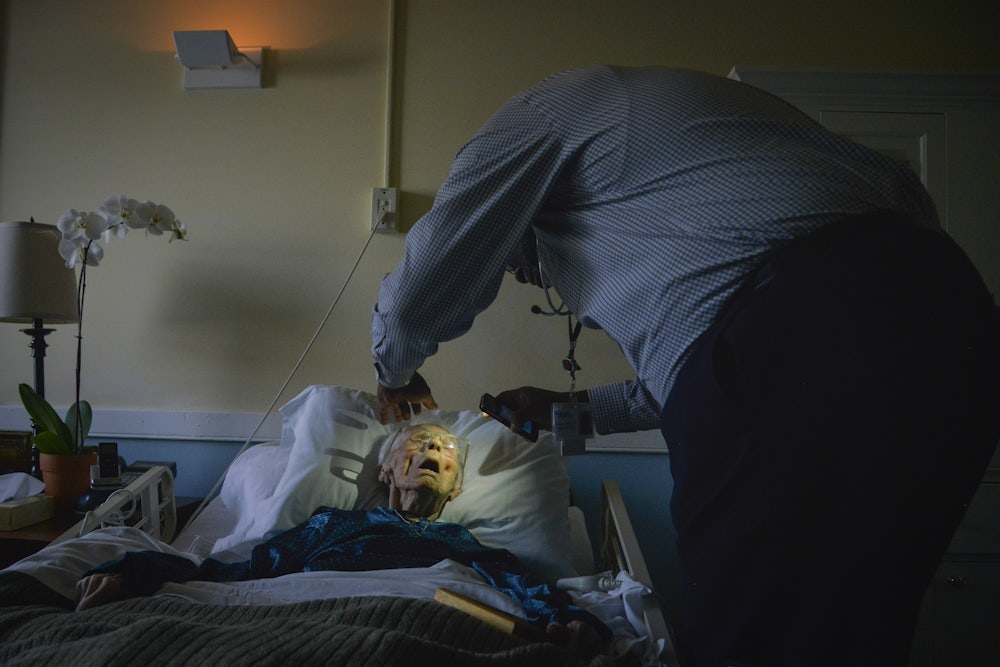Every great cause, wrote the American longshoreman and philosopher Eric Hoffer, begins as a movement, becomes a business, and eventually degenerates into a racket. One can only imagine how appalled the conservative Hoffer, who died in 1983, would be to learn that this principle extends even to government-funded hospice care, as ProPublica’s Ava Kofman documented in a shocking story last month on the industry and its abuses.
Eighteen years ago, when my first wife was dying of liver cancer, she received wonderful hospice care during the last week or so of her life from a local nonprofit hospice. Hospices were the invention of a British nurse turned physician named Cicely Saunders. The idea was to free terminal patients from the tyranny of hospital care and allow them to live out their final days with dignity, either at home or in a hospice facility. The movement spread to America, and in 1979 Medicare started experimenting with funding hospice. In 1985, President Reagan signed a law making the Medicare hospice benefit permanent. As Kofman notes, at least part of the appeal for conservatives was that it was a simple way to save money, since hospice benefits were conditioned on the patient forgoing any medical intervention except to relieve pain and suffering.
What I didn’t know back in 2005 was that hospice was already transforming itself from a reform movement into a racket. Back then, about one-third of all hospices were for-profit. Today, more than 70 percent are.
Hospices have lately become a hot investment for private equity, which typically requires a 20 to 30 percent return on investment. Between 2011 and 2019, the number of hospices owned by private equity firms tripled. “Private equity is trying to sell typically in three to seven years,” Robert Tyler Braun, an assistant professor at Cornell Medical School who’s studied private equity’s role in hospice, told me.
Let’s say Private Equity Firm A buys a well-run hospice. That hospice becomes the “platform agency.” Firm A adds to that platform other small hospices (“roll-up acquisitions”) to increase its value (derived largely from Medicare and Medicaid payments). After five years the hospice is worth $1 billion. Time to sell to another private equity firm.
Enter Private Equity Firm B.
Firm B has $500 million in the bank. To buy, it raises an additional $500 million from a syndicate of investors. The hospice (not Private Equity Firm B) will have to pay that back, with interest. Profitability must therefore increase through cuts, economies of scale, vertical integration with pharmacies or medical equipment companies—whatever. Three to seven years later, the hospice will be worth $2 billion and it will be time to sell again. Tra la la.
The results of this cannibalization are amply documented in Kofman’s excellent story: aggressive harvesting of hospice prospects, the most valued of whom are not especially sick; dumping hospice patients before the hospice’s average length of stay exceeds six months, the point at which Medicare demands repayment; avoiding, in most cases, seriously ill patients likely to die too soon to furnish the desired revenue stream.
Some hospice firms bribe physicians to bring them new patients by offering all-expenses-paid trips to Las Vegas nightclubs.… Other audacious for-profit players enlist family and friends to act as make-believe clients, lure addicts with the promise of free painkillers, dupe people into the program by claiming that it’s free home health care or steal personal information to enroll “phantom patients.” … In Frisco, Texas, according to the FBI, a hospice owner tried to evade the Medicare-repayment problem by instructing staff to overdose patients who were staying on the service too long. He texted a nurse about one patient: “He better not make it tomorrow. Or I will blame u.”
Usually a for-profit hospice will be looking for patients who don’t die too quickly. An elderly person with dementia is ideal because you can have dementia for a really long time, incurring little in the way of cost. Elderly hospice patients with cancer are problematic because they die too fast. A conference on “Long Term Care and the Law,” held earlier this year in Orlando, offered not one but two separate panels on “Serving and marketing to non-cancer patients in nursing homes.” (Italics mine.) Hospice companies often work in collaboration with nursing-home facilities, another favored investment these days for private equity firms.
Many studies have compared for-profit hospice care with nonprofit hospice care. For-profit care does not come off well. In 2019, the inspector general’s office of the Department Health and Human Services released a report on hospice deficiencies—bad management, inadequate assessments of patients, insufficiently vetted staff, etc.—that found 67 percent of the poor performers were for-profit hospices. A Government Accountability Office report that same year revealed that 77 percent of for-profit hospice patients had the highly prized “non-cancer” diagnosis, compared to only 69 percent of nonprofit hospice patients. (Suckers!) Not coincidentally, the for-profit hospices were found to be much better than the nonprofits at extracting money from the Treasury. The GAO report also found that caregivers rated 15 percent of for-profit hospices poorly, compared to only 4 percent of nonprofit hospices.
I asked several critics of hospice care’s commercialization why Medicare consents to reimburse for-profit hospices. To my surprise, they insisted that a bright-line distinction would be unfair because there are good for-profit hospices and bad nonprofit hospices. Well, of course—but only in the particular, not in the aggregate. The standard reformist response to stories like Kofman’s is to call for more inspections and more aggressive oversight. “The hospices that were described in that story should lose their licenses,” Joan Teno, a former hospice director and adjunct professor at Brown who’s a leading expert on the industry, told me. But “it would be mind-boggling,” she said, if the government “could legally say, ‘I’m sorry, we’re not going to pay for for-profit healthcare.’”
My mind is not boggled.
The Centers for Medicare & Medicaid Services are never going to be able to solve this problem through oversight alone. There are 4,639 Medicare-certified hospices nationwide, mostly providing services in God knows how many people’s homes. Shortcuts will be needed to restore high-quality care. The easiest shortcut is for Medicare to refuse to certify for-profit hospices for government payments. This was never supposed to be an industry.
Would the government be telling for-profit hospices that they may not operate, in violation of the sacred principle of free enterprise? Of course not. It would merely be the government telling for-profit hospices to stop sucking on the government teat.
My idea wouldn’t go over well with congressional Republicans. Did I mention that the largest hospice in the country, VITAS Healthcare, was founded by Don Gaetz, father to Representative Matt Gaetz? (Don and three partners sold the company in 2004 for more than $400 million.) Conservatives are supposed to be jealous guardians of the public purse, but lately they’ve made an exception for for-profit businesses that thrive on public expenditures: Medicare Advantage, for-profit colleges, etc. Today, the favored conservative model for government spending is to funnel it through profit-hungry corporations. Eric Hoffer would be shocked.
But this is my money, damn it, and yours. Kofman’s story made me angrier than anything I’ve seen in a long while. Private equity companies and other investors do not have a God-given right to buy and sell hospices like hotels on a Monopoly board. People are dying, and they just want a little help getting across the River Styx. In Greek mythology, the ferryman Charon never demanded more than a single silver coin, placed reverently in the mouth of the deceased. Now the dead are themselves the currency. It’s squalid, and we don’t have to let it continue.






